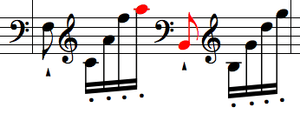La campanella
"La campanella" (Italian for "The little bell") is the nickname given to the third of Franz Liszt's six Grandes études de Paganini, S. 141 (1851). It is in the key of G-sharp minor. This piece is a revision of an earlier version from 1838, the Études d'exécution transcendente d'après Paganini, S. 140. Its melody comes from the final movement of Niccolò Paganini's Violin Concerto No. 2 in B minor, where the tune was reinforced metaphorically by a 'little handbell'. This is illustrated by the large intervals of 16th notes in the right hand.[1][2][3]
- Incipit for "La campanella" by Franz Liszt (Grandes études de Paganini S. 141 no. 3)
The étude is famous for being one of the most difficult pieces ever written for piano.[4] It is played at a brisk allegretto tempo and features right hand jumps between intervals larger than one octave, sometimes even stretching for two whole octaves within the time of a sixteenth note. As a whole, the étude can be practiced to increase dexterity and accuracy at large jumps on the piano, along with agility of the weaker fingers of the hand. The largest intervals reached by the right hand are fifteenths (two octaves) and sixteenths (two octaves and a second). Sixteenth notes are played between the two notes, and the same note is played two octaves or two octaves and a second higher with no rest. Little time is provided for the pianist to move the hand, thus forcing the pianist to avoid tension within the muscles. Fifteenth intervals are quite common in the beginning of the étude, while the sixteenth intervals appear twice, at the thirtieth and thirty-second measures.

However, the left hand studies about four extremely large intervals, larger than those in the right hand. For example, in bar 101, the left hand makes a sixteenth-note jump of just a half-step below three octaves. The étude also involves other technical difficulties, e.g. trills with the fourth and fifth fingers.
The work has been arranged by other composers and pianists, most notably Ferruccio Busoni and Marc-André Hamelin.
References
- Ben Arnold, The Liszt Companion, 2002, p. 101: " By far, the most performed of these studies is the revised version of La campanella with its engaging wide leaps, ..."
- Alan Walker, Reflections on Liszt, 2005, p. 30: "The five Paganini caprices, plus a free arrangement of "La campanella" which also appeared in 1838, later formed the six Études d'exécution transcendente d'après Paganini. "
- editor Richard Taruskin, Oxford History of Western Music, 5-book set, 2009: "Besides a streamlined version of La campanella, the set included five of Paganini's Caprices freely transcribed, including two of these given above in Ex. 5–1a. Liszt's versions are shown in Ex. 5–5."
- Maddy Shaw Roberts (8 February 2019). "These are the hardest pieces ever written for the piano". Classic FM. Retrieved 28 August 2019.
External links
- Grandes études de Paganini: Scores at the International Music Score Library Project (IMSLP)
- Free sheet music of "La campanella" from Cantorion.org